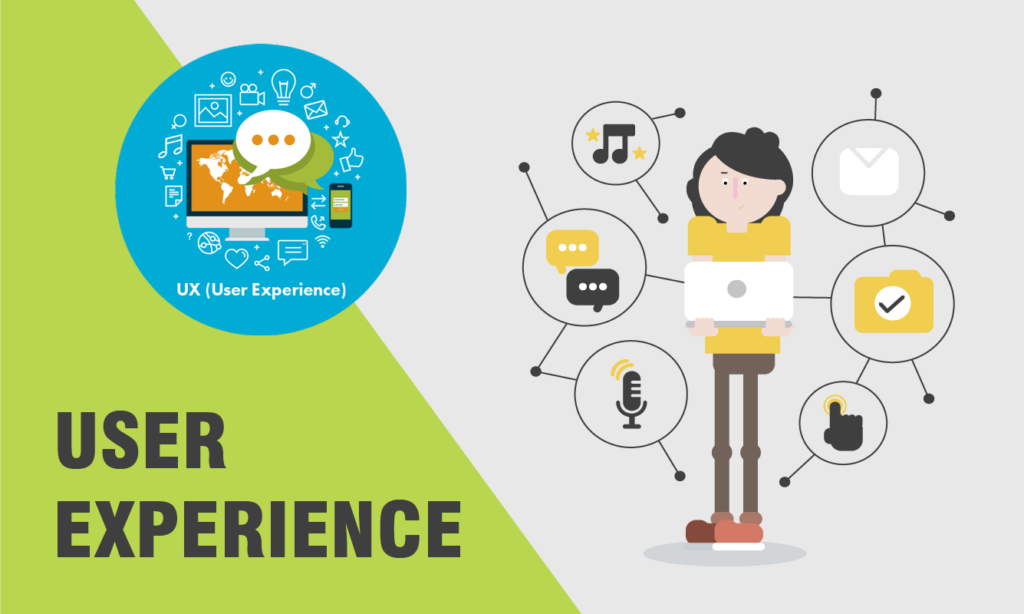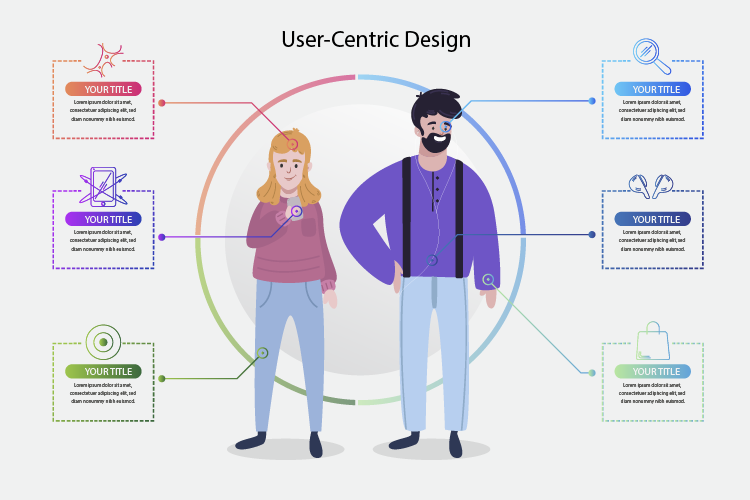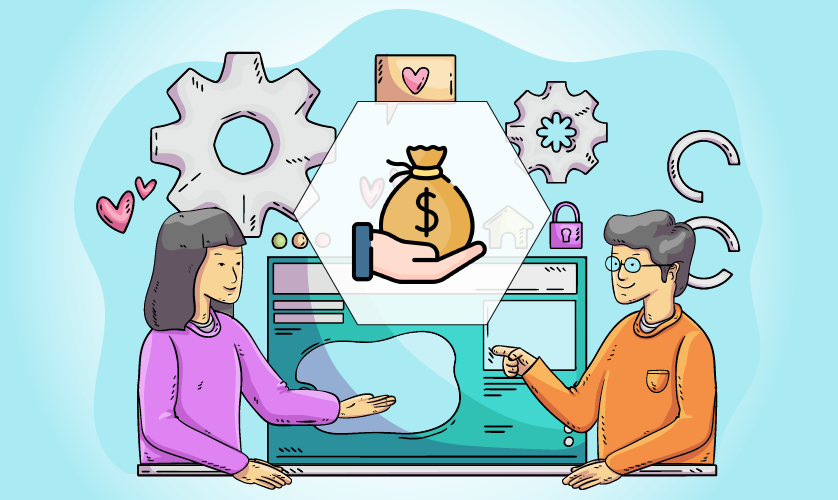User experience is a key factor to consider when designing products, services, Applications, and websites. It is all about understanding the needs of your users and creating a design that makes it easy and enjoyable for them to interact with your product. To ensure a good user experience, it is important to understand the target audience and their goals, create a clear and intuitive user interface, provide helpful feedback and error messages, and allow for customization. Ultimately, the goal is to provide an enjoyable and rewarding experience for the user. Designing for users should be an approach that focuses on their needs, wants, and abilities. It should be a creative process that takes into account their goals and objectives, as well as how they interact and use the product/service. It should also be an iterative process, with constant feedback and testing, to ensure the design is meeting the needs and wants of the users. Ultimately, the goal should be to create a design that is intuitive, user-friendly, and interactive.
It encompasses everything from the design, usability, and functionality of a product. To create a successful user experience, it’s essential to understand user needs and goals and to design a product that meets those needs and encourages users to achieve their goals. user experience tips for developing products from the perspective of Users:

Understand your users. Gather data and use it to build personas and understand user needs.

UX design principles are a set of guidelines that aim to create a more enjoyable, efficient, and engaging user experience. They include things such as creating a consistent design language, making sure the design is user-friendly and intuitive, ensuring the design is accessible to all users and making sure the design is aesthetically pleasing. Additionally, UX design principles often focus on creating a design that is not only visually appealing but also one that is easy to navigate and use.
The 7 principles of User Experience (UX) design are:

1) User-Centric Design: User-centric design is a design philosophy that focuses on creating products and services that are tailored to meet the needs and preferences of the user. This approach puts the user at the centre of the design process, taking into account the user’s needs, wants, and goals when creating a product or service. The user-centric design focuses on creating an intuitive user experience that is both aesthetically pleasing and easy to use. It also emphasizes a continuous feedback loop between the user and the product/service to ensure that it meets the user’s needs. By creating a user-centric design, companies can create products and services that users love and engage with.
2) Accessibility and Inclusivity: Accessibility and inclusivity are important values that should be embraced by all organizations. We should strive to ensure that everyone has the same opportunities to participate, regardless of any physical, mental, or emotional limitations. This can be done by making sure that our services, products, and communications are accessible to everyone, and by creating an inclusive environment where everyone feels welcome and respected. Additionally, it is important to understand the unique needs and challenges of each individual and to provide appropriate accommodations and support.
3) Clarity and Simplicity: Clarity and simplicity are two of the most important considerations when producing any type of written work. Clarity can be achieved by using language that is easy to understand, avoiding jargon and long, complicated sentences, and logically organizing ideas. Simplicity is important for ensuring that the text is concise and easy to follow, and for ensuring that only the most important information is included.
4) Consistency and Standards: Consistency and standards are important to ensure the quality of a product or service. To maintain these levels, it is important to have consistent processes, best practices, and metrics in place. This will enable teams to work together more efficiently and produce results that meet the desired standards. Additionally, having clear communication and expectations helps to ensure that everyone is on the same page and that all tasks are completed accurately and on time.
5) Efficiency and Automation: Efficiency and automation can be great ways to streamline your workflow and save time. Many tools and services can help you automate tasks and processes, from automation software to task management tools. Additionally, if you’re looking for ways to improve the efficiency of your workflow, there are a few tips you can follow: break down your tasks into smaller, more manageable chunks, prioritize tasks based on importance, and use automation software to automate repetitive tasks. By following these tips, you can be sure to increase efficiency and save time.
6) Usability and Optimization: Usability and optimization are key elements of any successful website. Making sure your website is easy to use and navigate for users is essential, as it allows them to access the information and services they need quickly and without any confusion. Additionally, optimizing your website for search engines will ensure that your content is easily discoverable by your target audience and you can maximize your online visibility. To achieve this, you should focus on creating high-quality content that is relevant to your audience, using keywords and phrases that are often used in searches related to your website, and optimizing your website for speed and performance. With these steps, you can ensure your website has the best chance of success.
7) Aesthetics and Delight: Aesthetics and delight can be found in many different forms and contexts. From the beauty of a sunrise over the ocean to the pleasure of a delicious meal, or the joy of spending time with friends and family, aesthetics and delight can be experienced in a variety of ways. It is important to be mindful of the beauty and pleasure around us and to take time to appreciate the small things in life. in user experience design we keep in mind how the design look in fits our users By being open to the possibilities of aesthetics and delight, we can have moments of joy in our lives that will stay with us forever.
All of these principles come together to create an optimal user experience by making sure that the user’s needs are met in an intuitive, efficient, and pleasing manner.

Understanding the function of UX deliverables is key to developing effective user experiences. UX deliverables are documents that are created in the process of user experience design. They can range from sketches, wireframes, user stories, and prototypes, to usability test plans and reports. Each of these deliverables has a specific purpose in the design process and is used to help teams develop user-centred designs. Sketches and wireframes are used to plan out the layout and structure of a product, while user stories help to capture the user’s perspective. Prototypes can be used to test out and iterate on a design before it’s released to the public, while usability test plans provide instructions for conducting tests and analyzing the results. By understanding the purpose of these UX deliverables, you can create effective strategies for user experience design.
Creating UX deliverables helps UX designers:

A UX designer is someone who creates user experiences that are interactive and intuitive for users. They use research, analysis, and testing to understand how users interact with a product or website, and then use that information to create designs that are user-friendly and efficient. creating wireframes and user flow, designing banners and buttons, or even making good type fonts that appear in the product. This could include deciding on the layout of a website, making sure navigation is easy to use, and designing visuals that are engaging and pleasing to the eye. UX designers are also responsible for ensuring that a user’s experience with the product or website is intuitive and easy to use.

UI (User Interface) design focuses on the look and feel of a product. It is responsible for the visuals, layout, typography, and interactive elements of a product.
recommended Software used for UI Design is Adobe XD Figma and a few designers use Adobe Photoshop also.
UX (User Experience) design focuses on the user’s interaction with the product. It encompasses research, strategy, information architecture, and usability testing to create an experience that is both efficient and enjoyable for the user.
recommended Software used for UX Design in Adobe XD Figma, invision, Balsamiq, web flow, Protopie, and Sketch.

User experience (UX) is an incredibly valuable concept for product design because it takes into consideration the user’s needs and wants when creating a product. UX design focuses on the user’s journey and experience with the product, making sure that the product is intuitive, easy to use, and meets the user’s needs. A good UX design also takes into account user feedback, allowing for the product to be continuously improved upon. UX design also looks at how the user interacts with the product, and how the product fits into the user’s lifestyle or environment. Taking all of these factors into consideration ensures that the product is designed with the user in mind, making it more likely that the user will enjoy and use the product. UX (User Experience) plays an important role in product design. UX involves the process of optimizing a product’s usability, accessibility, and desirability for its target users. It can involve user research, competitor analysis, personas, wireframing, prototyping, usability testing, and more. By taking into account user needs, goals, and feedback, UX helps to create products that are intuitive, user-friendly, and aesthetically pleasing.

The average salary of a UX designer varies depending on experience, location, and company. Generally speaking, the average salary range for a UX designer typically falls between $50,000 – $100,000 per year, with top earners making as much as $150,000. in India it depends on the different cities starting salary is 25k per month and after the experience, it goes up to Rs 10,0000 per month It’s important to note that salaries can also vary based on the specific duties and responsibilities of the role, so it’s worth researching your potential employer to get a better understanding of what to expect.

There are many great tools available for UI and UX design. Some of the most popular ones include Figma, Adobe XD, Sketch, and InVision. Each of these tools offers great features, such as drag-and-drop user interface customization, exportable asset libraries, and the ability to collaborate with other designers.
Adobe Figma: Figma is software for Creating a User interface design, user experience design, wireframing, Prototyping, and making user flow also it’s very easy to collaborate for projects with other programmers and designers. Recently adobe acquired Figma it’s a Great deal for both Parties.
adobe XD: Adobe XD is an excellent tool for designing and prototyping websites and mobile apps. It allows you to create wireframes and interactive prototypes quickly and easily, and it also offers features such as auto-animate, which makes it easy to create interactive elements with minimal effort. Additionally, you can use Adobe XD to collaborate with your team and stakeholders, and share feedback and ideas. If you’re looking for a powerful and easy-to-use tool for your design projects, Adobe XD is worth a look!
Invision: InVision is a powerful design collaboration platform that allows teams to create interactive prototypes and collaborate on projects in one space. With InVision, teams can access shared workflows, review assets, comment on designs, and test their prototypes on any device. InVision also provides tools to monitor design performance, measure user feedback, and manage design systems. By leveraging InVision’s cloud-based platform, teams can save time and resources while ensuring their designs are consistent, up-to-date, and of the highest quality.
User experience is becoming increasingly important in the industry. Companies are recognizing the need to provide their customers with an enjoyable, intuitive, and pleasurable experience when interacting with their products and services. They are investing in creating user-friendly interfaces and developing innovative solutions to improve user experiences. By creating positive user experiences, companies can increase customer satisfaction, foster brand loyalty, and ultimately drive business growth.
Question: What does user experience mean?
Answer: User experience (UX) is the overall experience of a user when interacting with a product, system, or service. It encompasses how easy and intuitive the product is to use, how visually appealing it is, and how it meets the user’s needs. UX is an important factor in the success of any product, system, or service and is something that should be taken into consideration when designing and developing any type of digital product.
Question: what does a user experience UX Designer do?
Answer: A User Experience (UX) Designer creates digital experiences that are intuitive, engaging, and easy to use. They work to ensure that users have a positive experience when interacting with a product or service. UX Designers use research and data to inform their designs and then create prototypes, wireframes, and storyboards to bring their designs to life. UX Designers often collaborate with other teams such as marketing, development, and engineering to ensure that the products they design meet the needs of users.
Question: Is UX design a high-paying job?
Answer: It depends on the individual and the company. Generally, UX design is a well-paid job with salaries varying depending on the level of seniority, experience, and the organization you are working for. It is also important to note that UX design is a highly competitive field and the ability to demonstrate your knowledge and experience can be a major factor in determining the salary you can command.
Leave A Comment